Related Research Articles

Ice hockey is a team sport played on ice skates, usually on an ice skating rink with lines and markings specific to the sport. It belongs to a family of sports called hockey. In ice hockey, two opposing teams use ice hockey sticks to control, advance, and shoot a closed, vulcanized, rubber disc called a "puck" into the other team's goal. Each goal is worth one point. The team which scores the most goals is declared the winner. In a formal game, each team has six skaters on the ice at a time, barring any penalties, one of whom is the goaltender. Ice hockey is a full contact sport, and is considered to be one of the more physically demanding team sports. It is distinct from field hockey, in which players move a ball around a non-frozen pitch using field hockey sticks.
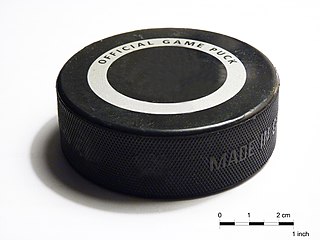
A hockey puck is either an open or closed disk used in a variety of sports and games. There are designs made for use on an ice surface, such as in ice hockey, and others for the different variants of floor hockey which includes the wheeled skate variant of inline hockey. They are all designed to serve the same function a ball does in ball games.

Teemu Ilmari Selänne is a Finnish former professional ice hockey winger. He began his professional career in 1989–90 with Jokerit of the SM-liiga and played 21 seasons in the National Hockey League (NHL) for the Winnipeg Jets, Anaheim Ducks, San Jose Sharks, and Colorado Avalanche. Nicknamed "the Finnish Flash", Selänne is the highest scoring Finn in NHL history, and one of the highest overall; he retired in 2014 11th all-time with 684 goals and 15th with 1,457 points. He holds numerous team scoring records for both the Winnipeg/Arizona franchise and the Anaheim Ducks. His jersey number 8 was retired by the Ducks in 2015. In 2017 Selänne was named one of the '100 Greatest NHL Players' in history. On June 26, 2017, Selänne was elected to the Hockey Hall of Fame as the second Finn after Jari Kurri.

In ice hockey, a goal is scored when the puck entirely crosses the goal line between the two goal posts and below the goal crossbar. A goal awards one point to the team attacking the goal scored upon, regardless of which team the player who actually deflected the puck into the goal belongs to. Typically, a player on the team attempting to score shoots the puck with their stick towards the goal net opening, and a player on the opposing team called a goaltender tries to block the shot to prevent a goal from being scored against their team.
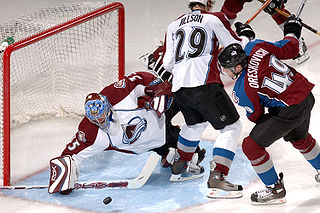
In ice hockey, the goaltender is the player responsible for preventing the hockey puck from entering their team's net, thus preventing the opposing team from scoring. The goaltender mostly plays in or near the area in front of the net called the goal crease. Goaltenders tend to stay at or beyond the top of the crease to cut down on the angle of shots. In the modern age of goaltending there are two common styles, butterfly and hybrid. Because of the power of shots, the goaltender wears special equipment to protect the body from direct impact.
In ice hockey, a penalty shot is a type of penalty awarded when a team loses a clear scoring opportunity on a breakaway because of a foul committed by an opposing player. A player from the non-offending team is given an attempt to score a goal without opposition from any defending players except the goaltender. This is the same type of shot used in a shootout to decide games in some leagues.

A slapshot is a powerful shot in ice hockey. Its advantage is as a high-speed shot that can be taken from a long distance; the disadvantage is the long time to set it up as well as its low accuracy.

A shot in ice hockey is an attempt by a player to score a goal by striking or snapping the puck with their stick in the direction of the net.

There are two styles of gloves worn by ice hockey players. Skaters wear similar gloves on each hand, while goaltenders wear gloves of different types on each hand.
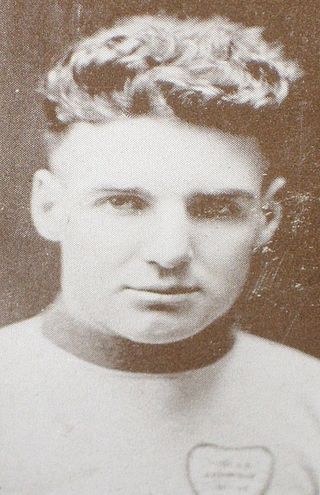
Cecil Henry "Babe" Dye was a Canadian professional ice hockey forward who played 11 seasons in the National Hockey League (NHL) for the Toronto St. Patricks/Maple Leafs, Hamilton Tigers, Chicago Black Hawks, and the New York Americans between 1919 and 1930. Born in Hamilton, Ontario, Dye was known as an excellent stick-handler, and goal-scorer.
A wrist shot is a type of hockey shot that involves using arm muscles to propel a puck forward from the concave side of the blade of a hockey stick. Generally, when the puck is shot in a similar manner using the convex side of the blade, it is referred to as a backhand shot. The power of a wrist shot comes from lower body strength more than arm strength. The advantage of a wrist shot over a slap shot is the minimal amount of setup required, creating an element of surprise. Moreover, a wrist shot is far more accurate than a slap shot. Conversely, the reliance on wrist and forearm muscles to propel the puck causes the wrist shot to be less powerful than the slap shot, though this is not true for all players, even those with "big shots". Transfer of bodyweight and the flex of a hockey stick are also key factors for a wrist shot. Weight should shift from the back leg to the front leg for maximum power. The flex of a stick is also key for a powerful wrist shot. Applying energy and weight onto your stick gives a whip like motion and thus provides your shot with even more power. The lower the flex number on a hockey stick, the more bend the stick creates.
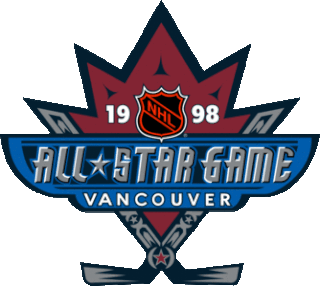
The 1998 National Hockey League All-Star Game took place at General Motors Place in Vancouver, home to the Vancouver Canucks, on January 18, 1998.

The Miracle on Manchester is the nickname given to a National Hockey League (NHL) playoff game between the Los Angeles Kings and Edmonton Oilers that took place on April 10, 1982 in the league's 65th season. The game, the third in a best-of-five postseason series, was played at The Forum, the Kings' home arena at the time, which was situated on Manchester Boulevard in the Los Angeles suburb of Inglewood. The Kings completed the largest comeback in NHL playoff history, going from being down 5–0 to win the game in overtime, 6–5. Combined with upset wins in Games 1 and 5, the Kings eliminated the Gretzky-led Oilers in a 3–2 series victory to reach the second round.

The 1997 National Hockey League All-Star Game took place on January 18, 1997, at San Jose Arena in San Jose, home of the San Jose Sharks. The final score was Eastern Conference 11, Western Conference 7. This game was originally scheduled for the 1994–95 season, but was cancelled due to the 1994–95 NHL lockout.
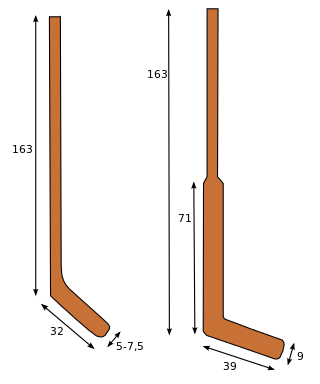
An ice hockey stick is a piece of equipment used in ice hockey to shoot, pass, and carry the puck across the ice. Ice hockey sticks are approximately 150–200 cm long, composed of a long, slender shaft with a flat extension at one end called the blade. National Hockey League (NHL) sticks are up to 63 inches long. The blade is the part of the stick used to contact the puck, and is typically 25 to 40 cm long. Stick dimensions can vary widely, as they are usually built to suit a particular player's size and preference. The blade is positioned at roughly a 135° angle from the axis of the shaft, giving the stick a partly 'L-shaped' appearance. The shaft of the stick is fairly rigid, but is slightly elastic to improve shot performance.
This is a list of common terms used in the sport of ice hockey along with the definitions of these terms.
Donald Kennedy McSween is an American former professional ice hockey player who played in the National Hockey League (NHL) for two clubs in the late 1980s and early 1990s.

In ice hockey, players use specialized equipment both to facilitate the play of the game and for protection as this is a sport where injuries are common, therefore, all players are encouraged to protect their bodies from bruises and severe fractures.
In ice hockey, a pass is the movement of the puck from one player to another, usually by a motion of the stick. A pass differs from a shot, in that a pass is typically weaker than a shot and is not directed at the opponent's net with the intention of scoring a goal. The function of passing in ice hockey during gameplay strongly resembles the role of passing in other goal sports such as soccer and lacrosse. Passing is one of the most fundamental skills in hockey. An effective pass is described as being "stick to stick" or "tape to tape", referring to the tape on the blade of a hockey stick. Effective passing requires good vision, anticipation, and timing, as well as execution. A player that is an effective passer will normally record many assists, which are awarded to the second and third to last player to touch the puck before a goal. The National Hockey League record for most career assists is 1,963 by Wayne Gretzky, who is considered one of the best passers of all time. Different types of passes are employed in different situations or using different techniques:
References
- ↑ "Powerful Tips To Improve Your Hockey Snap Shot". Beer League Hockey.
- Shackel, Brian; Alexander, Marion. "Hockey Snap Shot Checklist" (PDF). University of Manitoba website. Archived from the original (PDF) on 28 December 2013. Retrieved 29 July 2012.